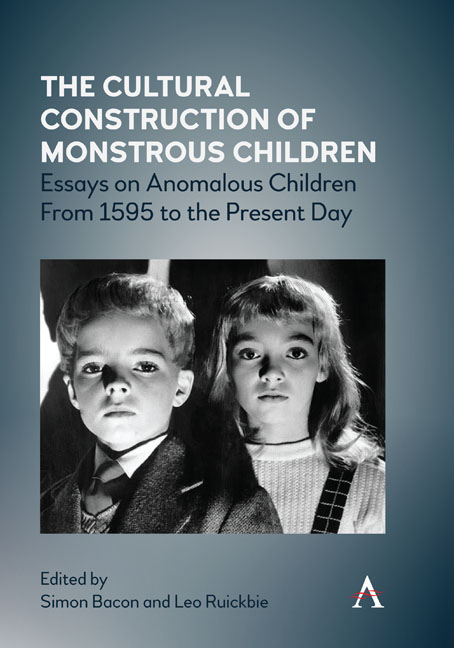 The Cultural Construction of Monstrous Children
The Cultural Construction of Monstrous Children Book contents
- Frontmatter
- Contents
- List of Illustrations
- Acknowledgements
- Introduction
- Part I Historical Case Studies
- Part II Factual Anxiety in Fictional Representations: The Undead Child
- Part III Factual Anxiety in Fictional Representations: The Monstrous Child
- Part IV Cultural Categorization in the Past, Present and Possible Future
- Notes on Contributors
- Index
Chapter Two - The Naughty Little Children: The Paranormal and Teenagers
Published online by Cambridge University Press: 20 January 2022
- Frontmatter
- Contents
- List of Illustrations
- Acknowledgements
- Introduction
- Part I Historical Case Studies
- Part II Factual Anxiety in Fictional Representations: The Undead Child
- Part III Factual Anxiety in Fictional Representations: The Monstrous Child
- Part IV Cultural Categorization in the Past, Present and Possible Future
- Notes on Contributors
- Index
Summary
Introduction
In his novel Théorie de la Vilaine Petite Fille (Theory of the naughty little girl), the French writer Hubert Haddad described several episodes from the tumultuous lives of the Fox sisters, the ‘mediums’ attributed with launching American spiritualism. Surprisingly, he never explained the origin and associated issues signified by his title. His use of it is also peculiar because it was only 50 years after the events that occurred around the Fox family that this theory took its name. Indeed, this theory was coined by Frank Podmore (1856– 1910), one of the principal and most sceptical investigators of the Society for Psychical Research (SPR), founded in Cambridge in 1882, who developed this interpretation in 1886, using the phrase in a response to reviews of the work of Andrew Lang and Alfred Russell Wallace in 1899. During the 79th general meeting of the SPR in April 1896, presided over by the famous physicist William Crookes, Podmore explained the results of his investigation into 11 cases of ‘Poltergeists’, each of which he concluded was a fraud. The frauds involved a girl eight times and a boy three times. He added that in almost every case, the young ‘agent’ was physically or psychologically abnormal. Although this theory was criticized by some members of the SPR, it still remained central to the ongoing discussions on the place of the teenager within the hauntings, suggesting they were the privileged agents of fraudulent manipulation or mediumistic personalities with the associated signifiers of somatic and mental troubles. All things considered, it was deemed that the children deserved special attention.
To understand the implications of this theory, it is necessary to look more closely at the studies that link adolescence, occultism and parapsychology, with an especial focus on one case that highlights the main issues involved as published by Dr Joseph Grasset in 1904.
Adolescence and Occultism
In many ways adolescence and occultism are moving categories arbitrarily defined as the product of socio-historical constructions. It is not so unsurprising then that they have become so commonly associated in works of popular culture that express our deepestanxieties, such as fantasy and horror movies or – which is possibly more disturbing though increasing prevalent – discourses warning against the evils of young people and occult practices.
- Type
- Chapter
- Information
- The Cultural Construction of Monstrous ChildrenEssays on Anomalous Children from 1595 to the Present Day, pp. 39 - 52Publisher: Anthem PressPrint publication year: 2020


